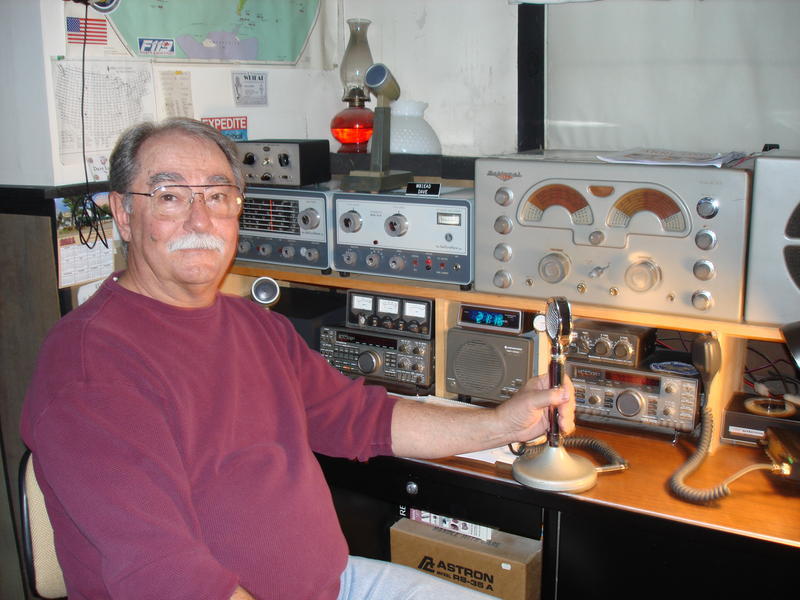For Dave LaPierre, 64, the magic begins every day at 8:30 a.m. That’s when he grabs a cup of coffee and heads down to “the shack” for his regular chat with a group of guys on his same wave length.
LaPierre and his breakfast club are amateur radio operators who convene for a serving of ham before starting their day. Their banter begins with the flip of a switch, the turn of a dial and the exchanging of identities via designated call letters.
Here, no sentences overlap and each man waits his turn to speak – their pauses punctuated by the crackle and hum of radio waves signaling in the background.
The “shack” is an amateur radio term to describe a center of operations. For LaPierre, that is in the basement of his Biddeford home. While many modern ham operators transmit using just a microphone, transceiver and antenna, LaPierre’s setup has all of the modern contrivances plus a large collection of working vintage receivers, transmitters, microphones and wattage meters dating to 1935.
The space features a meticulously kept 360-degree panorama of electronic devices, many of them antiques, that range from transistor to tube technology. Here old televisions, radios and ham radio equipment find new life alongside a generous store of parts, all organized by type and lot in drawers and on shelves. LaPierre restores as a hobby, earning limited profits that he uses to purchase new items or parts.
“I don’t do this for the money,” said LaPierre. “I do it for the simple joy of restoring a piece of equipment that someone may have enjoyed as a child and putting it back into their hands.”
LaPierre’s love affair with electronics began at age 10, when he received a Global 9 pocket transistor radio for his birthday. He discovered his gift for gadgetry and gab when he removed the radio’s back cover to see how the components worked. LaPierre’s tinkering and ingenuity took him further than he ever imagined. With the turn of a few screws and the addition of some wire, he was talking to people in faraway lands like Russia and China.
Today, LaPierre is still awed by what he calls, “the magic” of making contact with another person, bypassing international boundaries and political affiliations to discover commonalities.
Attempting to explain the science of ham radio is a lofty idea for most of us. But after 30 years of transmitting and reading nearly every book written on the subject, LaPierre rattles off the particulars with the ease of a master chef listing the ingredients and method for making a souffle.
He spoke of solar-charged ions, bandwidths and radio frequencies traveling through the information super highway located far above the Earth. Here audio transmissions are converted into electronic signals that are picked up by other ham operators and reconverted back into audible messages through transmitters, receivers, antennas and other equipment. Early on, LaPierre briefly embraced citizen’s band radio, but he said was not satisfied to operate on limited bandwidths and channels and a lack of restrictions on the use of foul or suggestive language.
By comparison, amateur radio operators are licensed by the Federal Communications Commission and must adhere to a code of ethics, including language and privacy clauses. Hams must pass a written exam to receive their own personal call letters.
“We are allowed to transmit and communicate within several bands of operation, starting from the standard AM band to beyond satellite communications,” LaPierre said.
LaPierre’s signaling work has occasionally interrupted a telephone conversation or television program. And, once, a late-night transmission filtered through a neighbor’s iPod as she slept. But LaPierre’s setup is a courteous operation.
He is a 30-year member of the American Radio Relay League, that affords him access to the latest resources and technology, a monthly magazine subscription and eligibility to win awards for the number and global range of contacts he makes each year.
Hams trade personal contact cards documenting their call letters and details of their initial contacts and mail them to each other as a record of the verbal exchange. LaPierre also keeps log books of those conversations, jotting down the time, station, frequency and station those conversations occurred on. A recent page in his log boasts chats with other hams in Wales, the Netherlands, Gambia, Italy, Germany, Wisconsin, Ohio and Maine.
Ham operator licenses can be obtained online for as little $30 and few as 10 hours of study. Instruction and licensing also is available to those who want to operate in a higher classification. To learn more about amateur radio, go to www.arrl.org/.
Staff Writer Deborah Sayer can be contacted at 791-6308 or at: dsayer@pressherald.com
Send questions/comments to the editors.



Success. Please wait for the page to reload. If the page does not reload within 5 seconds, please refresh the page.
Enter your email and password to access comments.
Hi, to comment on stories you must . This profile is in addition to your subscription and website login.
Already have a commenting profile? .
Invalid username/password.
Please check your email to confirm and complete your registration.
Only subscribers are eligible to post comments. Please subscribe or login first for digital access. Here’s why.
Use the form below to reset your password. When you've submitted your account email, we will send an email with a reset code.